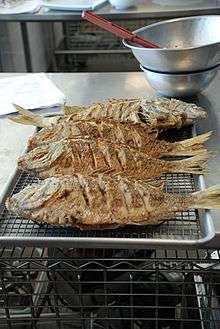Scup
The scup (Stenotomus chrysops) is a fish which occurs primarily in the Atlantic from Massachusetts to South Carolina.[1] Along with many other fish of the family Sparidae, it is also commonly known as porgy.[2]
| Scup | |
|---|---|
 | |
| Scientific classification | |
| Kingdom: | |
| Phylum: | |
| Class: | |
| Order: | |
| Family: | |
| Genus: | Stenotomus |
| Species: | S. chrysops |
| Binomial name | |
| Stenotomus chrysops (Linnaeus, 1766) | |

Scup grow as large as 18 in (450 mm) and weigh 3 to 4 lb (2 kg), but they average 0.5–1.0 lb (0.25–0.50 kg). Scup can live up to 20 years; females can begin to reproduce at the age of two.[3] Every year female scups lay approximately 7,000 eggs in sand and weed abundant areas.[4]
In the Middle Atlantic Bight, scup spawn along the inner continental shelf. Their larvae end up in inshore waters, along the coast and in estuarine areas. At two to three years of age, they mature. Scup winter along the mid and outer continental shelf. When the temperature warms in the spring, they migrate inshore.[5]
They are fished for by both commercial and recreational fishermen. The scup fishery is one of the oldest in the United States, with records dating back to 1800. Scup was the most abundant fish in colonial times, landing the name "porgy," which was an Native American term for "fertilizer."[6] Fishermen began using trawls in 1929, which increased catches dramatically. The species was termed overfished in 1996, and today there is evidence of a rebound. Today, scup are still caught primarily using an otter trawl.[7]
Many consumers like their light flavor and they are sometimes called panfish. Popular methods of cooking include but are not limited to frying, broiling, and baking.
Management
Scup are heavily fished commercially and recreationally. Management measures for the species generally include size limits, bag limits, fishing seasons, and equipment requirements. Scup are also managed through quotas that are separately regulated during the different seasons.[8] In Massachusetts, management plans result in the distribution of 78% of the yearly permitted harvest of scups for commercial purposes, and 22% for recreational fishing.[9]
Fishing
Since Scups are classified as anglers and tackle bait frantically, squid strips are the most common choice of bait because they stay intact and suspended on the hook after several strikes.[10]
See also
- Porgie fishing
References
- "Stenotomus chrysops". Integrated Taxonomic Information System. Retrieved 19 March 2006.
- Froese, Rainer and Pauly, Daniel, eds. (2006). "Stenotomus chrysops" in FishBase. January 2006 version.
- Fisheries, NOAA (2020-07-21). "Scup | NOAA Fisheries". NOAA. Retrieved 2020-07-30.
- "Learn about: Scup". Mass.gov. Retrieved 2020-07-30.
- Scup, Stenotomus chrysops, Life History and Habitat Characteristics
- http://www.fishthelimits.com/porgy-fish/
- Scup NOAA FishWatch. Retrieved 5 November 2012.
- "Learn about: Scup". Mass.gov. Retrieved 2020-07-30.
- "Learn about: Scup". Mass.gov. Retrieved 2020-07-30.